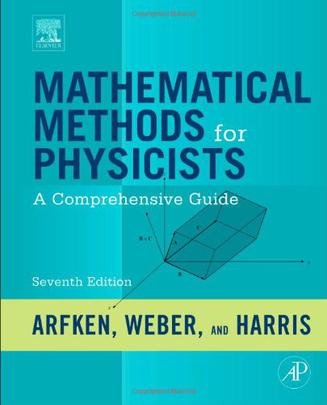目录
Preface
1 Mathematical Preliminaries
1.1 Infinite Series
1.2 Series of Functions
1.3 Binomial Theorem
1.4 Mathematical Induction
1.5 Operations on Series Expansions of Functions
1.6 Some Important Series
1.7 Vectors
1.8 Complex Numbers and Functions
1.9 Derivatives and Extrema
1.10 Evaluation of Integrals
1.11 Dirac Delta Function
Additional Readings
2Determinants and Matrices
2.1 Determinants
2.2 Matrices
Additional Readings
3 Vector Analysis
3.1 Review of Basic Properties
3.2 Vectors in 3-D Space
3.3 Coordinate Transformations
3.4 Rotations in R3
3.5 Differential Vector Operators
3.6 Differential Vector Operators: Further Properties
3.7 Vector Integration
3.8 Integral Theorems
3.9 Potential Theory
3.10 Curvilinear Coordinates
Additional Readings
4 Tensors and Differential Forms
4.1 Tensor Analysis
4.2 Pseudotensors, Dual Tensors
4.3 Tensors in General Coordinates
4.4 Jacobians
4.5 Differential Forms
4.6 Differentiating Forms
4.7 Integrating Forms
Additional Readings
5 Vector Spaces
5.1 Vectors in Function Spaces
5.2 Gram-Schmidt Orthogonalization
5.3 Operators
5.4 Self-Adjoint Operators
5.5 Unitary Operators
5.6 Transformations of Operators
5.7 Invariants
5.8 Summary-Vector Space Notation
Additional Readings
6 Eigenvalue Problems
6.1 Eigenvalue Equations
6.2 Matrix Eigenvalue Problems
6.3 Hermitian Eigenvalue Problems
6.4 Hermitian Matrix Diagonalization
6.5 Normal Matrices
Additional Readings
7 Ordinary Differential Equations
7.1 Introduction
7.2 First-Order Equations
7.3 ODEs with Constant Coefficients
7.4 Second-Order Linear OD. Es
7.5 Series Solutions--Frobenius' Method
7.6 Other Solutions
7.7 Inhomogeneous Linear ODEs
7.8 Nonlinear Differential Equations
Additional Readings
8 Sturm-Liouville Theory
8.1 Introduction
8.2 Hermitian Operators
8.3 ODE Eigenvalue Problems
8.4 Variation Method
8.5 Summary, Eigenvalue Problems
Additional Readings
9 Partial Differential Equations
9.1 Introduction
9.2 First-Order Equations
9.3 Second-Order Equations
9.4 Separation of Variables
9.5 Laplace and Poisson Equations
9.6 Wave Equation
9.7 Heat-Flow, or Diffusion PDE
9.8 Summary
Additional Readings
10 Green's Functions
10.1 One-Dimensional Problems
10.2 Problems in Two and Three Dimensions
Additional Readings
11 Complex Variable Theory
11.1 Complex Variables and Functions
11.2 Cauchy-Riemann Conditions
11.3 Cauchy's Integral Theorem
11.4 Cauchy ' s Integral Formula
11.5 Laurent Expansion
11.6 Singularities
11.7 Calculus of Residues
11.8 Evaluation of Definite Integrals
11.9 Evaluation of Sums
11.10 Miscellaneous Topics
Additional Readings
12 Further Topics in Analysis
12.1 Orthogonal Polynomials
12.2 Bernoulli Numbers
12.3 Euler-Maclaurin Integration Formula
12.4 Dirichlet Series
12.5 Infinite Products
12.6 Asymptotic Series
12.7 Method of Steepest Descents
12.8 Dispersion Relations
Additional Readings
13 Gamma Function
13.1 Definitions, Properties
13.2 Digamma and Polygamma Functions
13,3 The Beta Function
13.4 Stirling's Series
13.5 Riemann Zeta Function
13.6 Other Related Functions
Additional Readings
14 Bessel Functions
14.1 Bessel Functions of the First Kind, Jv (x)
14.2 Orthogonality
14.3 Neumann Functions, Bessel Functions of the Second Kind
14.4 HankeI Functions
14.5 Modified Bessel Functions, Ir(x) and Ky(x)
14.6 Asymptotic Expansions
14.7 Spherical Bessel Functions
Additional Readings
15 Legendre Functions
15.1 Legendre Polynomials
15.2 Orthogonality
15.3 Physical Interpretation of Generating Function
15.4 Associated Legendre Equation
15.5 Spherical Harmonics
15.6 Legendre Functions of the Second Kind
Additional Readings
16 Angular Momentum
16.1 Angular Momentum Operators
16.2 Angular Momentum Coupling
16.3 Spherical Tensors
16.4 Vector Spherical Harmonics
Additional Readings
17 Group Theory
17.1 Introduction to Group Theory
17.2 Representation of Groups
17.3 Symmetry and Physics
17.4 Discrete Groups
17.5 Direct Products
17.6 Symmetric Group
17.7 Continuous Groups
17.8 Lorentz Group
17.9 Lorentz Covariance of Maxwell's Equations
17.10 Space Groups
Additional Readings
18 More Special Functions
18.1 Hermite Functions
18.2 Applications of Hermite Functions
18.3 Laguerre Functions
18.4 Chebyshev Polynomials
18.5 Hypergeometric Functions
18.6 Confluent Hypergeometric Functions
18,7 Dilogarithm
18.8 Elliptic Integrals
Additional Readings
19 Fourier Series
19.1 General Properties
19.2 Applications of Fourier Series
19.3 Gibbs Phenomenon
Additional Readings
20 Integral Transforms
20.1 Introduction
20.2 Fourier Transform
20.3 Properties of Fourier Transforms
20.4 Fourier Convolution Theorem
20.5 Signal-Processing Applications
20.6 Discrete Fourier Transform
20.7 Laplace Transforms
20.8 Properties of Laplace Transforms
20.9 Laplace Convolution Theorem
20.10 Inverse Laplace Transform
Additional Readings
21 Integral Equations
21.1 Introduction
21.2 Some Special Methods
21.3 Neumann Series
21.4 Hilbert-Schmidt Theory
Additional Readings
22 Calculus of Variations
22.1 Euler Equation
22.2 More General Variations
22.3 Constrained Minima/Maxima
22.4 Variation with Constraints
Additional Readings
23 Probability and Statistics
23.1 Probability: Definitions, Simple Properties
23.2 Random Variables
23.3 Binomial Distribution
23.4 Poisson Distribution
23.5 Gauss' Normal Distribution
23.6 Transformations of Random Variables
23.7 Statistics
Additional Readings
Index
【展开】
【收起】
内容简介
Now inits 7th edition, Mathematical Methods for Physicists continues to provide all the mathematical methods that aspiring scientists and engineers are likely to encounter as students and beginning researchers. This bestselling text provides mathematical relations and their proofs essential to the study of physics and related fields. While retaining thekey features of the 6th edition, the new edition provides a more careful balance of explanation, theory, and examples. Taking a problem-solving-skills approach to incorporating theorems with applications, the book's improved focus will help students succeed throughout their academic careers and well into their professions. Some notable enhancements include more refined and focused content in important topics, improved organization, updated notations, extensive explanations and intuitive exercise sets, a wider range of problem solutions, improvement in the placement, and a wider range of difficulty of exercises. Revised and updated version of the leading text in mathematical physics Focuses on problem-solving skills and active learning, offering numerous chapter problems Clearly identified definitions, theorems, and proofs promote clarity and understanding New to this edition: Improved modular chapters New up-to-date examples More intuitive explanations
【展开】
【收起】
下载说明
1、追日是作者栎年创作的原创作品,下载链接均为网友上传的的网盘链接!
2、相识电子书提供优质免费的txt、pdf等下载链接,所有电子书均为完整版!
下载链接
